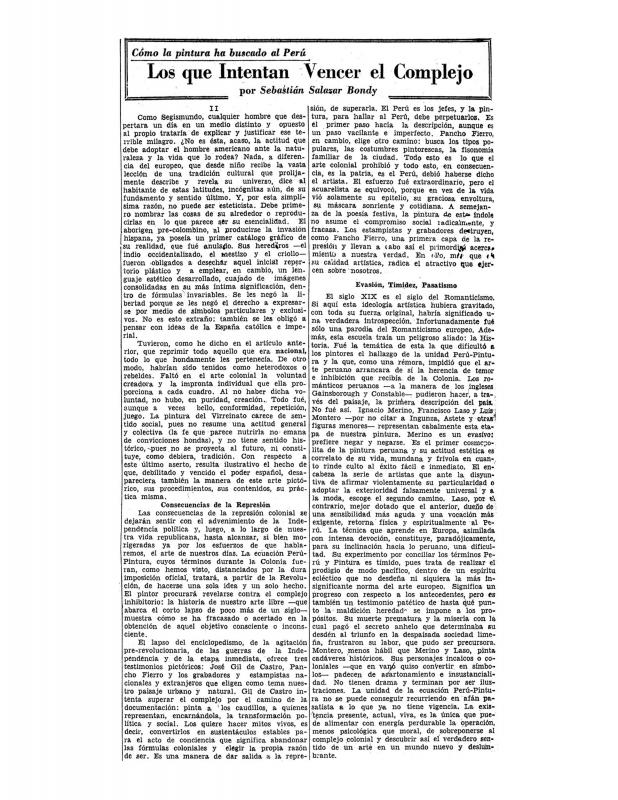Perhaps the main cause for rejection of abstract art in Peru in the fifties was its identification with “the cosmopolitan,” epitomized in the negative image of the “countriless” described in this article by writer Sebastián Salazar Bondy (1924–65) published in La Prensa newspaper (Lima, July 13, 1954). In this text, Salazar Bondy voices a passionate defense of “county folk”—those spiritually tied to the “nation”—as fundamental artistic value. Two days after this article was published, Salazar Bondy would return to this theme in his remarks on the exhibition of Surrealist painters held in July 1954 at the Galería de Lima. Part of an ambitious season of international art that would leave its mark on the Peruvian capital, this was the first show held in the country of works by major Surrealists like Francis Picabia, René Magritte, Wifredo Lam, and Max Ernst. Before works of this nature, there was no way to avoid discussing the role played by Surrealism in modern art and its formation; otherwise polarized local criticism came together to oppose that movement’s turn to a “non-figurative” vision. Salazar Bondy and writer Juan Ríos (1914–91) saw under the initial vitality and frankness of those canvases an incipient decadence: self-referential—abstract—art in no way connected to the common man. Modern theorist and architect Luis Miró Quesada Garland (1914–94) upheld the other position, seeing in those Surrealist works a gradual honing of visual values. He defended cosmopolitanism, ironically confronting the idea of “country folk” with passages from Salazar Bondy’s remarks on the show. In his rebuttal, Salazar Bondy stated that he considered his exchange with Miró Quesada Garland to have come to an end, since his rival had sunk to such low levels.
[For further reading on the debates between Peruvian modernists and advocates of socially committed art, see the following articles in the ICAA digital archive: by Fernando de Szyszlo “Dice Fernando Syszlo que no hay pintores en el Perú ni América: el joven pintor peruano declara sentir su pintura y la de los demás pero no puede explicarla” (doc. no. 1137793); and by critic Samuel Pérez Barreto “Pintura: la guerra de los pintores: plumas por pinceles” (doc. no. 1137839), “Arte: la guerra de los pintores” (doc. no. 1137856), and “Polémica: ‘polémica Espacio’” (doc. no. 1137916). See as well writer Sebastián Salazar Bondy’s lecture “Cómo la pintura ha buscado al Perú,” published in three parts: “El arte colonial entendido como represión” (doc. no. 1138058), “Los que intentan vencer el complejo” (doc. no. 1138075), and “Hallazgo de la realidad perdida: siglo XX” (doc. no. 1138092). Other texts by Salazar Bondy pertinent to the debate on nationalism include “En torno al desarraigo” (doc. no. 1138565) and “Punto final” (doc. no. 1138231). On the other side of the debate, see the column written by Miró Quesada Garland, the primary framer of Peruvian artistic modernism, entitled “En blanca y negra” (doc. no. 1138753), (doc. no. 1138772), (doc. no. 1138599), (doc. no. 1138620), (doc. no. 1138718), and (doc. no. 1138248)].















